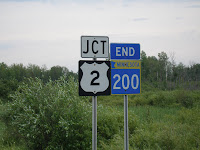 Many Americans love their cars. I'm not one of them, but I do love what I can do with one. Since my life of leisure began in 2004, I've visited dozens of National Parks and Monuments, hiked hundreds of miles of trails, and seen thousands of stars in the night sky over a campground. Getting out into what passes for wilderness in our time and place is a balm for the soul. But the truth is, thepart I love most about these trips is the driving.
Many Americans love their cars. I'm not one of them, but I do love what I can do with one. Since my life of leisure began in 2004, I've visited dozens of National Parks and Monuments, hiked hundreds of miles of trails, and seen thousands of stars in the night sky over a campground. Getting out into what passes for wilderness in our time and place is a balm for the soul. But the truth is, thepart I love most about these trips is the driving.I am a great aficionado for an empty highway, especially one that leads to distant mountains, or winds through the badlands, or traces the course of a small river. I'll often follow such a road for mile after mile, going far out my way--if I even had a "way" to begin with. As much as I am a slave to my wanderlust, my great driving fantasies always involve following a multistate highway across its entire length, something I've accomplished just once--Route 200.
Like its more famous (and well-traveled) brethren US 2 and Interstates 90 and 94, Route 200 crosses the so-called northern tier of states. As highway numbers go, it is a rarity:
 a state highway that maintains its number across three state boundaries. (Why this is so, I've not been able to determine.) Along its approximately 1,343 mile course, it takes its enraptured passenger through, along, or over everything a blue highway enthusiast could ask for. It starts as a Scenic Byway around Lake Pend Oreille in Idaho, follows the Clark Fork River between the Cabinet and Coeur d'Alene Mountains, crosses the Continental Divide at Rogers Pass, takes in the sweeping plains of eastern Montana and the Badlands of the Upper Missouri River, and ends amidst Minnesota's Ten Thousand Lakes. You can take Route 200 to Missoula or Great Falls, or if you prefer, to Ah-Gwah-Ching (MN) or to Zap (ND). It's the front yard of Theodore Roosevelt National Park in North Dakota, and the welcome mat for Lake Itasca State Park in Minnesota, where the Mississippi River begins its journey to the sea. For most of its length, it's an unassuming little two-lane highway, unaware of its own grandeur, and it carries comparatively little traffic, which is best for a scenery-appreciating slow driver like me.
a state highway that maintains its number across three state boundaries. (Why this is so, I've not been able to determine.) Along its approximately 1,343 mile course, it takes its enraptured passenger through, along, or over everything a blue highway enthusiast could ask for. It starts as a Scenic Byway around Lake Pend Oreille in Idaho, follows the Clark Fork River between the Cabinet and Coeur d'Alene Mountains, crosses the Continental Divide at Rogers Pass, takes in the sweeping plains of eastern Montana and the Badlands of the Upper Missouri River, and ends amidst Minnesota's Ten Thousand Lakes. You can take Route 200 to Missoula or Great Falls, or if you prefer, to Ah-Gwah-Ching (MN) or to Zap (ND). It's the front yard of Theodore Roosevelt National Park in North Dakota, and the welcome mat for Lake Itasca State Park in Minnesota, where the Mississippi River begins its journey to the sea. For most of its length, it's an unassuming little two-lane highway, unaware of its own grandeur, and it carries comparatively little traffic, which is best for a scenery-appreciating slow driver like me.I had intended to tackle the more ambitious US 50 crossing this year, a three thousand mile ribbon of asphalt connecting Ocean City to Sacramento, but my financial situation will not permit this boondoggle. But it still makes a wonderful dream, and it costs very little to dream.






